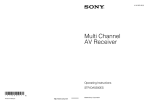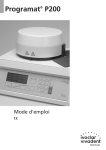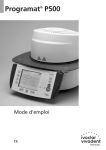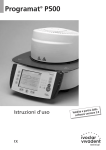Download USAGE STRUCTURE AND DESIGN MG-1000
Transcript
Installation and Operating Instructions Differential pressure transmitter for potentially explosive areas Mimablad: 176GB/1999-10-25 Ersätter: MG-1000-EEx USAGE MG-1000-EEx is suitable for use in measurement and control circuits in air treatment processes where explosive gases can exist temporarily or permanently. The design permits use in risk areas classified Zone 0, 1 and 2 when the ignition temperature for the explosive gas exceeds 135 ºC. STRUCTURE AND DESIGN MG-1000-EEx consists of two parts: the pressure transmitter MG-1000-T-EEx and the Supply unit MG-1000-M-EEx. Pressure transmitter The pressure transmitter is placed in the most appropriate position from a measurement and service point of view in the potentially explosive area. The measurement system is enclosed in a die-cast light metal housing and consists of an equalizer spring system in which a rubber membrane is suspended. The position of the membrane is sensed by an IR optical measurement system, after which the signal is amplified. The pressure transmitter is supplied in a steel enclosure with protection class IP66. Säkertarea område Safe Matningsdon Supply unit Givare Transmitter ∆p Explosionsfarligt område Potentially explosive area Supply unit The Supply unit is installed in the safe area. It contains a voltage supply unit, measurement value converter, indicator and output signal amplifier. The indicator is fitted on a special card and also includes the possibility of square root linearization for the flow indication and flow linear output signal. The indication of the flow and velocity can be adjusted to the requisite range using a strap and potentiometer. The decimal point can be placed in the desired position by strapping. The Supply unit has protection class IP44 and is equipped with a bracket for DIN rail EN50022. A transparent plastic cover protects the front panel and indicator. Electrical connections and setting of the desired output signal and made by removing the unit’s left-hand end plate. Behind the right-hand end plate is a terminal block for the intrinsically safe circuits and the setting of flow indication. Safety The pressure transmitter and Supply unit are designed according to the European standard EN 50014 and EN 50020 for intrinsic safety, explosion group and temperature class: * EEx ia IIC T4 for the pressure transmitter * [EEx ia] IIC for the Supply unit. Installation Pressure transmitter 1. Remove the cover from the enclosure. 2. Install the enclosure vertically on, e.g. a wall in the potentially explosive area. This is so the pressure measurement will be correct. 3. The capacitance of the cable between the pressure transmitter and the Supply unit must NOT exceed 38 nF (also see TECHNICAL DATA). 4. Strip the cable’s outer sheath so that the conductors are approx. 10 cm long. Now insert the cable through the cable gland. 5. Fold down the conductors in the centre of each terminal and cut, strip and connect. 6. Ensure the conductors are not strained and then tighten the cable gland. 7. Connect the enclosure to earth. PRESSURE CONNECTION The pressure connection to the pressure transmitter should be made using Micatrone’s impulse line kit to obtain secure and sealed operation. (Data sheet MDS-1249/94). The measurement outlet is connected via an 8/6 mm pneumatic HT plastic tube. * Positive pressure is connected to the + outlet. * Negative pressure is connected to the – outlet. When measuring the differential pressure the highest absolute pressure is connected to the + outlet. NOTE! Outlets not used are left open to the atmosphere. Supply unit 1. Fit the DIN rail in an appropriate position. Make sure there is sufficient space to remove the end plates with a screwdriver. 2. Remove both end plates and push the Supply unit onto the rail. 3. Pull out the base plate and fit the cable glands. The holes not used should be plugged again. 4. Strip the outer sheath on supply cable and the transmitter cable so that the conductors are approx. 20 cm long. Strip the outer sheath on the output signal cable so that the conductors are approx. 15 cm long. 5. Insert the cables in the cable glands and tighten. Fold down the conductors 90º towards the base plate. Slide in the base plate in the slot and fold up the conductors towards the terminal block. 6. Fold down the conductors in the centre of each terminal and cut, strip and connect. The enclosure is earthed by clamping the earth conductor between the nut strips below the terminal on the left-hand side. Also refer to the Swedish electro technical standard SS 421 08 21 with regard to the installation. SETTING THE OUTPUT SIGNAL ZERO POINT CALIBRATION Setting the output signal’s zero point 1. Remove the left-hand end plate on the Supply unit. 2. Setting takes place using the no. 1 and no. 2 dipswitches below the terminal block. No. 1 “ON” and no. 2 “OFF” gives 0…20 mA / 0…10 V No. 1 “OFF” and no. 2 “ON” gives 4…20 mA / 2…10 V 1. Before zero point calibration can take place the Supply unit must be voltage fed and the end plates screwed on for at least 60 minutes to reach its working temperature. 2. The output signal from the Supply unit is measured using an accurate digital volt/mA meter. 3. Set the block valve to the calibration position. If there is no block valve remove the pressure hoses from the pressure transmitter. 4. Adjust the zero point using the trimming potentiometer on the front of the pressure transmitter. Check that the Supply unit’s digital indicator shows zero in the pressure indication position (switch on the front in the left-hand position). 5. Reset the block valve (refit the hoses). OUTPUT SIGNAL OUTPUT SIGNAL The Supply unit is equipped with automatic switching between current and voltage output signals. With loads less than 400 Ω a current output signal is given and with loads greater than 600 Ω a voltage output signal is given. However, due to the Supply unit’s inner resistance the load should exceed 5k Ω with a voltage output signal. Avoid loading the output signal more than 400 Ω if a current output signal is required. The Supply unit can be blocked so that only the current output signal is obtained. This takes place by setting the dipswitch no. 3 in the “OFF” position. Auto. switching MAINTENANCE Normally the MG-1000-EEx requires no service, but we recommend that the zero point should be checked annually. Pressure linear output signal Only No 4 and no 5 dipswitches are used internally by the Supply unit and should be in the OFF position. Switching the output signal’s function 1. Remove the right-hand end plate. 2. Switching takes place with SW1 pos 5 & 6 on the Supply unit’s upper card. % of the pressure range Circuit card Circuit card Pos. 5 strapped gives pressure linear output signal Flow linear output signal Pos. 6 strapped gives flow linear output signal % of the pressure range SETTING THE FLOW INDICATION The flow indication is set according to the selected measurement element/measurement method. The indicator’s decimal point is selected using SW1 (placed on the upper card’s right-hand side in the Supply unit) pos. 1 & 2 and the range using pos. 3 & 4. The flow indication is finely trimmed using potentiometer P4. To adjust: remove the enclosure’s right-hand end plate and set the straps as shown below. Placement of the decimal point No decimal point Circuit card 000 The strap placed across pos. 1 & 2. Decimal point after the first digit Circuit card 0.00 The strap in pos. 2. Decimal point after the second digit Circuit card 00.0 The strap in pos. 1. Adjusting the indication using potentiometer P4 The adjustment ranges for P4 stated below apply when the flow linear output signal is 50% (25% differential pressure). Also refer to the diagram on the next page that shows the indicator’s value as a function of the flow linear output signal at the 4 different ranges. Adjustment range 0...300 Adjustment range 300...570 Circuit card “B3" Pos. 3 strapped. Adjustment range 570...810 Circuit card “B4" Pos. 4 strapped. Adjustment range 810...999 Circuit card “BU” Strap across pos. 3 & 4 on the upper row. Connect pressure to the pressure transmitter and read off the pressure on the Supply unit’s indicator with the switch on the front in the left-hand position (∆p). Now turn the switch to the right (V) and adjust the value using P4 on the right-hand side of the upper card according to the value read off from the measurement station’s diagram or the calculated value. Formula for calculating the velocity and flow. v = K m × ∆p m/s & = A × K × ∆p m3/s V m v = velocity in m/s Km = measurement probe’s flow constant ∆p = differential pressure in Pa & = flow in m3/s V Circuit card “BN” Strap across pos. 3 & 4 on the lowest row closest to the circuit card A = duct area in m2 Principle diagram of the Supply unit’s upper card Digital indicator Test outlet during manufacturing and servicing SW1 Pin strip for strapping Switch for the indicator Right position – flow Left position – pressure P4 Potentiometer to adjust the flow indication Display 999 BU 800 B4 B3 600 400 BN 200 10 20 30 40 50 60 70 80 90 100 Flödesutsignal (%) Flow linear output signal (%) Example: When the flow linear output signal is 65% (6.5 Volt with output signal 0-10 Volt) the indicator shall show 44.0 m3/h. The strap shall then be placed in position 3 (“B3”). TECHNICAL DATA, PRESSURE TRANSMITTER Supply voltage: 20 VDC (max 23,0 VDC) Protection class: IP66 Highest power that Pi = 0,64 W may be applied: Enclosure material: Powder coated sheet steel Highest current that Ii = 111 mA may be applied: Colour: RAL 7032 (Beige) Li = Negligible Electrical connection: 1 pc. PR 15.2 Internal inductance: Ci = 137 nF Pressure connection: 8/6 mm pneumatic hose Internal capacitance: Dimensions: Output signal: 4...20 mA, RLmax = 500 Ω B x H x D = 175 x 130 x 75 mm Weight: 1.6 kg Ambient temper- 0...40 °C ature: Measurement range: standard 0...100 Pa 0...200 Pa 0...500 Pa 0...1 kPa 0...2 kPa 0...5 kPa Measurement range: special Contact Micatrone for information regarding available measuring ranges(i.e -50...+50 Pa) Overload: Max 50 kPa Underload: Max 10 kPa Measurement accuracy according to IEC 770 Measurement < ± 0.8 % of the measureerror: ment range Hysteresis: < ± 1 % of the measurement range Repeatability: < 0.2 % of the measurement range Temperature operation: < 0.05 % / °C - 6 - TECHNICAL DATA, SUPPLY UNIT Supply voltage: 230 ± 20 VAC 50/60 Hz Power consump- Max 8 VA at 230 VAC tion: 400 Ω 400 Ω Ω Ω Output signal: pressure linear or flow linear (Electric isolation from supply voltage) 0...20 4...20 0...10 2...10 Indication: Pressure, flow or velocity with 3 digits mA, RLmax = mA, RLmax = Volt, Ri = 28 Volt, Ri = 28 Accuracy range according to IEC 770 The measuring accuracy for the pressure transmitter (MG-1000-T-EEx) is included in the following values: Measurement < ± 1 % of the measurement error: range Pressure linear output signal Measurement error: Flow linear output signal < ± 10 % of the measurement range at 0...10 % ∆p < ± 3 % of the measurement range at 10...100 % ∆p Hysteresis: < ± 1 % of the measurement range Repeatability: < 0.2 % of the measurement range Temperature operation: < 0.05 % / °C Protection class: IP44 Material enclosure: Aluminium/Plastic WIRING DIAGRAM Electrical connection: 6 PCS. PR 22,5 Scales: Pa, kPa, m/s, m3/s, m3/h or l/s Ambient temper- 0...40 °C ature: Matningsdon Supply unit Dimensions: B x H x D = 234 x 141 x 95 mm Weight: 1.7 kg Pressure Tryckgivare transmitter Vänster Höger sida Left-hand sidesida Right-hand side Protective Skyddsjord earth Fas Phase Noll Neutral Output Utsignal signal PE i+ L i- + Two-wire Tvåtrådsgivare - transmitter N + _ Supply to the pressure transmitter Max supply Nominal 20 VDC voltage: (max 22.2 VDC) ACCESSORIES Current: Max 111 mA Output power: Max 0.62 W Capacitance: Max 175 nF for the pressure transmitter and cable Inductance Max 2.0 mH for the pressure transmitter and cable * Impulse pipe kit, type VR-DR * Monoblock valve 2-TK with wall bracket * Flow measurement probe MFS Internal resistance: 450 Ω AB MICATRONE REGULATOR Dalvägen 8 S-169 56 SOLNA Phone: Fax: +46 8 470 25 00 +46 8 83 27 80 http://www.micatrone.se















